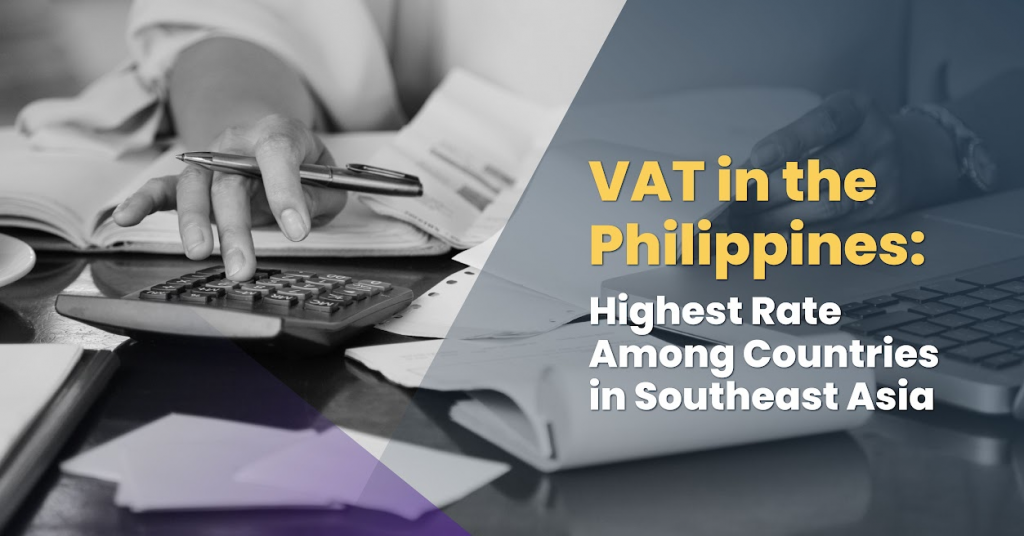
Value-added Tax or commonly known as VAT is a vital component in building a country’s economy. It serves as a significant source of revenue for governments worldwide. Just like any other country, the Philippines is no exception to the implementation of VAT on goods and services. However, compared to neighboring countries in Southeast Asia, the Philippines has the highest VAT rate. Understanding VAT and its impact is crucial for policymakers, businesses, and individuals alike. VAT plays a crucial role in shaping consumer behavior, investment decisions, and overall economic growth. In the case of the Philippines, its high VAT rate has both advantages and disadvantages. In this article, we’ll discuss what VAT means for the Philippines, its importance in driving economic activities, and how its VAT rate compares to neighboring countries in Southeast Asia.
| Country in Southeast Asia | Value-added Tax (VAT) Rate % |
| Brunei | No VAT |
| East Timor | No VAT, but levies on 2.5% sales rate |
| Myanmar | No VAT, but has 5% commercial rate |
| Thailand | 7% |
| Vietnam | 8% |
| Singapore | Goods and services tax = 8% |
| Cambodia | 10% |
| Laos | 10% |
| Malaysia | 10% |
| Indonesia | 11% |
| The Philippines | 12% |
What is Value-added Tax (VAT)
Value-Added Tax (VAT) is a type of sales tax that applies to goods, properties, and services in the Philippines, as well as to imported goods. It is imposed on transactions involving the sale, exchange, barter, or lease of these items. In essence, VAT is a tax on consumption, meaning that it is paid by consumers when they purchase goods or services. This revenue helps fund various government projects and services.
VAT is included in the price of goods and services, so consumers often don’t see it as a separate charge. Instead, it’s included into the total cost of a purchase. This makes it a relatively transparent form of taxation compared to other types of taxes.
A good example of this is when you purchase a product, goods, or services. Think of any purchase you’ve made recently. Like food (groceries, dining out), clothes, gas, any purchases. When you receive the receipt, take time to look at the bottom and you’ll see a line that says VAT. This means you’ve paid a bit extra for tax on your purchase which is already included in the total cost of your purchase. So, every time you buy something, you’re also contributing a bit to the Philippines funds by paying VAT.
What is the Purpose of Value-added Tax (VAT)
The purpose of Value-added Tax (VAT) is to generate revenue for the government by taxing the value added at each stage of production and distribution of goods and services. This tax system helps fund various government projects and public services, such as education, healthcare, infrastructure development, and social welfare programs. Additionally, VAT aims to create a more stable and predictable source of income for the government compared to other forms of taxation.
VAT Rates in Southeast Asia
In this section, we will provide an overview of the Value-Added Tax (VAT) rates across countries in Southeast Asia, from the highest to lowest rates.
- Brunei VAT rate – There is no VAT rate in Brunei
In Brunei, unlike many other countries in Southeast Asia, there is no Value-Added Tax (VAT) imposed.
- East Timor – No VAT yet, but levies on a 2.5% sales rate
Rather than implementing a value-added tax system, East Timor imposes a 2.5% sales rate on imported taxable goods.
- Myanmar – 5% Commercial Rate
Just like Brunei, Myanmar doesn’t have a VAT. But instead, a commercial rate ranging from 0%-8%, (which currently has a 5% general rate) is imposed as a turnover tax on both goods and services.
- Thailand – 7% VAT Rate
The standard VAT rate of Thailand is normally 10%, but it has been temporarily lowered to 7% until September 30, 2024, unless the government extends it further. VAT is charged on goods sold and services provided. Exported items are taxed at a zero rate, while specific goods and services, including basic groceries, education, healthcare, interest, leasing of immovable property, and real estate sales, are exempt from VAT.
- Vietnam – 8% VAT Rate
VAT in Vietnam applies to goods and services used for production, trading, and consumption in Vietnam (including goods and services purchased from non-residents), with certain exemptions.
- Singapore – 8% Goods and Services Tax
The Goods and services tax in Singapore is charged at 8% on the supply of goods and services made in Singapore by a taxable person in the course or furtherance of one’s business and on the importation of goods into Singapore.
- Cambodia – 10% VAT Rate
VAT in Cambodia applies to entities under the self-declaration regime and is levied at a rate of 10% on the value of most goods and services supplied.
- Laos – 10% VAT Rate
The 10% VAT rate of Laos applies to a variety of transactions, including imports, goods, general services, mineral imports, and electricity consumption.
- Malaysia – 10% VAT Rate
Sales tax is a type of tax imposed in Malaysia on taxable goods manufactured locally by a registered manufacturer, as well as on taxable goods imported by any person. It’s typically calculated as a percentage of the product’s value, known as an ad valorem tax.
These ad valorem rates typically range from 5% to 10%, depending on the type of goods.
Currently, specific rates of sales tax are applied primarily to certain classes of petroleum, such as refined petroleum. These ad valorem rates typically range from 5% to 10%, depending on the classification of the goods.
- Indonesia – 11% VAT Rate
The VAT law in Indonesia permits the government to adjust the VAT rate between 5% and 15%. As of April 1, 2022 until this is written, the VAT is generally applied at a rate of 11% on most sales of goods and services within Indonesia. Exported goods are subject to zero-rated VAT, while imported goods are subject to a VAT rate of 11%
- The Philippines – 12% VAT Rate
VAT in the Philippines is applied to nearly all service sales and imports, as well as the sale, exchange, or lease of goods or properties, whether tangible or intangible. The tax rate is a uniform 12% of the gross selling price for goods or properties sold, or gross receipts from service sales. For imported goods, VAT is based on the value determined by the Bureau of Customs (BOC), which includes customs duties, excise taxes, and other charges. If the BOC valuation is by volume or quantity, VAT is calculated based on the landed cost plus excise taxes.
FAQs about VAT rates in the Philippines
What Does Higher VAT Rates Mean?
Higher VAT rates implies increased taxes on goods and services purchased by consumers. This means that consumers will pay more for products and services subject to VAT, potentially leading to higher overall costs of living.
From a government perspective, higher VAT rates can result in greater tax revenue, which can be used to fund public services, infrastructure projects, and other government initiatives.
Does a High VAT Rate Have Negative Consequences for the Country?
A high VAT rate isn’t necessarily consequential for the country as they can also serve as a necessary tool for governments to raise revenue and address fiscal challenges. Higher VAT rates can provide governments with a stable and substantial source of income, which can be crucial for funding public services, infrastructure projects, and social welfare programs.
The only downside of having a high VAT rate is the financial burden passed down to consumers or buyers.
Is a Lower VAT rate better?
Lower VAT has its benefits for both consumers and businesses. Firstly, they can lead to reduced costs for consumers, making goods and services more affordable and improving purchasing power. This can stimulate consumer spending, which in turn can drive economic growth. Lower VAT rates can also enhance a country’s competitiveness in the global market by reducing the cost of exports.
Who has to pay VAT in the Philippines?
In the Philippines, VAT is typically paid by consumers when they purchase goods or services, as well as by businesses on their sales transactions.
Does paying VAT make you a taxpayer?
In a sense, yes. Paying VAT for purchased goods, products, and services is a contribution to the government’s tax policy.
Who has to file the VAT payments in the Philippines
In the Philippines, VAT is typically shouldered by the consumers, but the seller or the business who sold the goods, products, and services are responsible in filing VAT payments to the Bureau of Internal Revenue (BIR).
Sources









